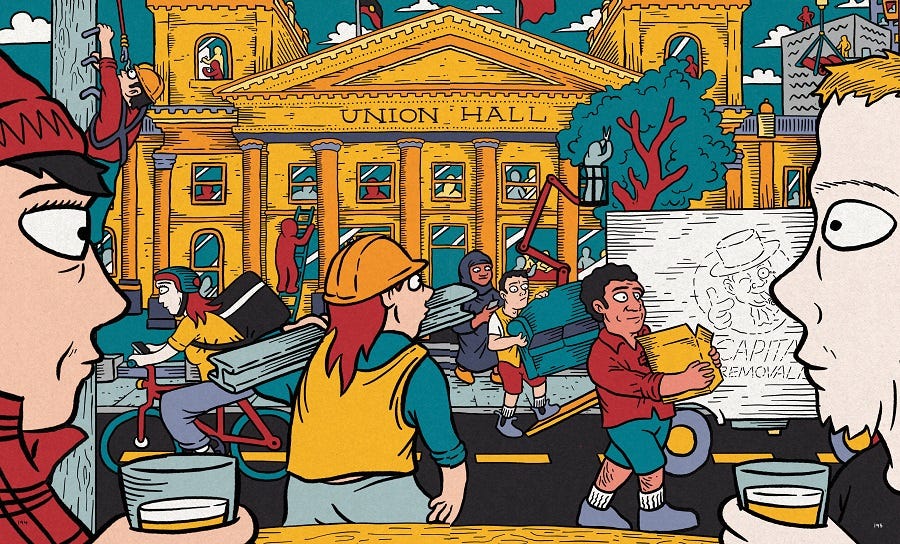Upon seeing Brett Story’s newest documentary, Union, at Sheffield DocFest, I reflected on the way three very recent artworks have portrayed the organizing of Amazon workers. This is in stark contrast to Amazon’s most famous previous media representation, namely, Chloe Zhao’s multiple-Oscar-winning 2020 Nomadland. This film received significant criticism for its neutral-to-sunny portrayal of the protagonist working a seasonal shift at an Amazon fulfillment site. (I don’t entirely disagree with these criticisms, but think the film had enough unique and interesting points [namely, the impossibility of eking out a fulfilling existence in late capitalism, a rejection of the nuclear family, a fervent call for the need to live other-wise and otherwise, and a semi-documentarian form] to balance the insufficient takedown of the Bezos behemoth).
In the last four years, Amazon has become, arguably, an even larger and more significant part of our cultural and economic lives. Take, for instance, comedian-cum-filmmaker-cum-musician-cum-media-studies-independent-scholar (fight me) Bo Burnham’s Bezos I, my favorite 58-second track of all time (and currently, with 225.5 million plays on Spotify), which enjoins:
Zuckerberg and Gates and Buffett
Amateurs can fucking suck it
Fuck their wives, drink their blood
Come on, Jeff, get 'em!
Media about Amazon, and Bezos’s obvious corrupt stupidity, seem to be a dime a dozen, but socialist art-makers are making especially good, and especially beautiful, art about unionizing Amazon.
I’ll start with the most seemingly-unlikely medium: a rug. Tabitha Arnold’s “Time Off Task” tapestry, completed in 2022, was acquired by the Boston Museum of Fine Art at the end of that year. As she wrote in her (incredible) Substack, she was inspired by the successful unionizing campaign at Staten Island’s JFK5, and the efforts of the ALU (Amazon Labor Union), then unaffiliated with any larger national union.
Arnold wrote: “In a way, I see my rugs as historical records. I want to continue the tradition of fiber art as a form of storytelling that transcends language, speaking to people in a direct and emotional way. This way, the rugs can visually communicate with viewers in the future; demonstrating the hierarchy of the capitalist workplace, the road to building union power, and the magnificent struggle of the labor movement today.”
I was lucky to have her participate in an April 2024 conference I organized at Penn, titled To Make the Revolution Irresistible: The Role of the Artist in the 20th Century. Tabitha Arnold and I met while painting placards and puppets for the 2021 Peoplehood Parade in Philadelphia, and I’ve been a fan of her work ever since.
While planning the conference at Penn, I was also teaching a graphic memoir grad seminar, and a fantastic new comic likewise spoke to the unionization of Amazon specifically, as well as unions more broadly: Sam Wallman’s 2022 Our Members Be Unlimited (Scribe).
The comic is dense, funny, and thoughtful, and speaks to both the history of unionization more broadly, and to its author-illustrator’s experiences working at an Amazon fulfillment center in Australia himself. The reader gets a historical overview of famous scenes in Union history— especially strikes in the first half of the 20th century— and is full of engaging art and information. Its art is clearly inspired by Matt Groening, and includes enough formal play to be far from didactic. My favorite section, close to the end of the book, zooms out (metaphorically and literally) to discuss the making of the book itself, and creates a thrillingly hyper-aware experience for the reader. It is the epitome of estrangement itself, and an incredibly fun moment.
Finally, a more recent work speaks to Amazon unionization through cinematic means: Brett Story’s Union (2024), which I was lucky to see at Sheffield DocFest this past week.
Brett Story’s Union should be essential viewing for any leftist (or liberal) in the US. The film follows the attempted unionization of the (aforementioned) Staten Island Amazon fulfillment center, JFK5. Anyone familiar with Story’s storied (ha) documentary practice will see traces of her previous work here, such as The Hottest August from 2019, and one of my favorite documentaries of all time. Story is clearly influenced by Chris Marker’s 1960s documentaries: August is a dead ringer for a NYC/climate change iteration of his 1962 Le Joli Mai. I spend quite a bit in my forthcoming book discussing Joli Mai, and argue that Marker is attempting an overtly subjective rejection of the new genre of cinema-verite, even as he uses some of the same techniques. Instead Marker does not attempt an ethnographic distance, but immerses himself fully into the lives of his subjects, despite not appearing on screen. He rejects what we consider “Direct Cinema” in favor of something engaged, not fly-on-the-fall; he is, after all, a committed communist.
So, too, with Brett Story. Her film on the unionization of Amazon is neither objective nor didactic; it follows the complexity and difficulty of union organizing (the petty arguments, the rivalries, the seemingly endless toil, but also the food, the camaraderie, the way solidarity can literally bring us to life). I was pleasantly surprised, also, to see an old acquaintance from the NYC DSA choir featured as one of the organizers (perhaps, in retrospect, not so shocking after all). Story’s film gorgeously depicts the beauty as well as the sheer labor of organizing— the struggle, seemingly against all odds. Yet it also doesn’t shirk from discussing the difficult facts: that despite unionization, it might still take years and years and years to reach a contract; that union busting can lose you your job; that the NLRB and the law will not always protect you; that bad actors, narcissists, and, quite frankly, shitty people, exist everywhere and everywhere. Yet this makes films like Story’s that much more necessary, and impactful, and true.









